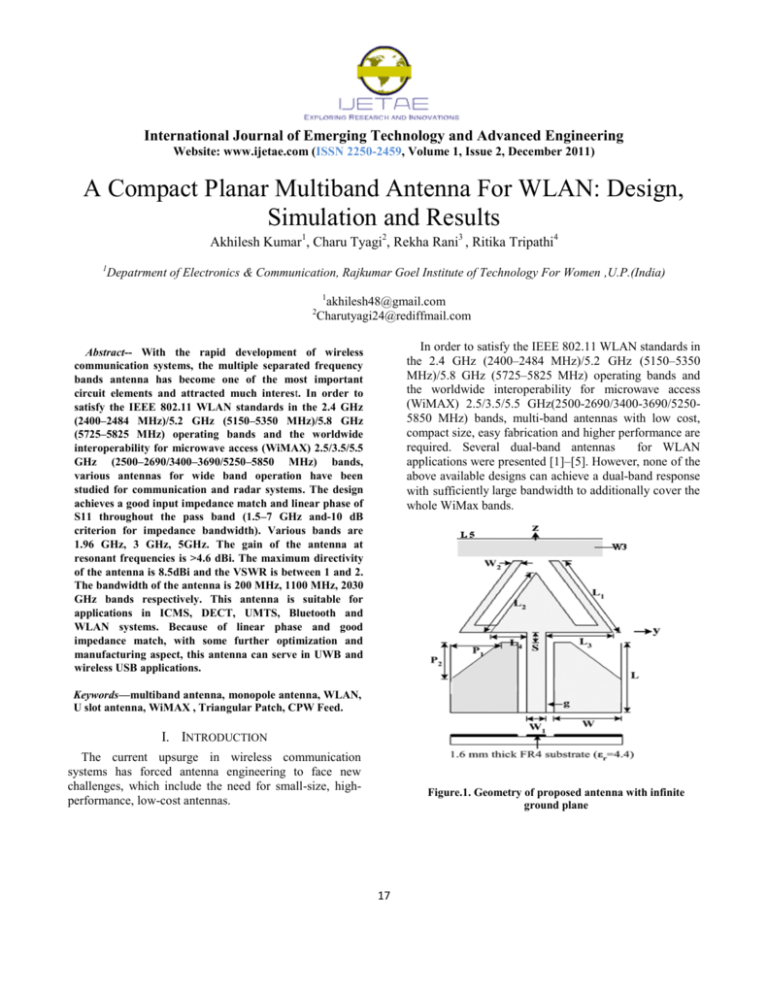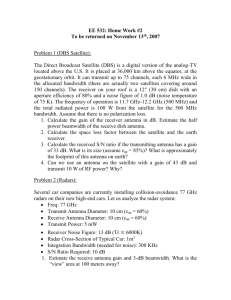A Compact Planar Multiband Antenna For WLAN: Design
advertisement

International Journal of Emerging Technology and Advanced Engineering Website: www.ijetae.com (ISSN 2250-2459, Volume 1, Issue 2, December 2011) A Compact Planar Multiband Antenna For WLAN: Design, Simulation and Results Akhilesh Kumar1, Charu Tyagi2, Rekha Rani3 , Ritika Tripathi4 1 Depatrment of Electronics & Communication, Rajkumar Goel Institute of Technology For Women ,U.P.(India) 1 akhilesh48@gmail.com Charutyagi24@rediffmail.com 2 In order to satisfy the IEEE 802.11 WLAN standards in the 2.4 GHz (2400–2484 MHz)/5.2 GHz (5150–5350 MHz)/5.8 GHz (5725–5825 MHz) operating bands and the worldwide interoperability for microwave access (WiMAX) 2.5/3.5/5.5 GHz(2500-2690/3400-3690/52505850 MHz) bands, multi-band antennas with low cost, compact size, easy fabrication and higher performance are required. Several dual-band antennas for WLAN applications were presented [1]–[5]. However, none of the above available designs can achieve a dual-band response with sufficiently large bandwidth to additionally cover the whole WiMax bands. Abstract-- With the rapid development of wireless communication systems, the multiple separated frequency bands antenna has become one of the most important circuit elements and attracted much interest. In order to satisfy the IEEE 802.11 WLAN standards in the 2.4 GHz (2400–2484 MHz)/5.2 GHz (5150–5350 MHz)/5.8 GHz (5725–5825 MHz) operating bands and the worldwide interoperability for microwave access (WiMAX) 2.5/3.5/5.5 GHz (2500–2690/3400–3690/5250–5850 MHz) bands, various antennas for wide band operation have been studied for communication and radar systems. The design achieves a good input impedance match and linear phase of S11 throughout the pass band (1.5–7 GHz and-10 dB criterion for impedance bandwidth). Various bands are 1.96 GHz, 3 GHz, 5GHz. The gain of the antenna at resonant frequencies is >4.6 dBi. The maximum directivity of the antenna is 8.5dBi and the VSWR is between 1 and 2. The bandwidth of the antenna is 200 MHz, 1100 MHz, 2030 GHz bands respectively. This antenna is suitable for applications in ICMS, DECT, UMTS, Bluetooth and WLAN systems. Because of linear phase and good impedance match, with some further optimization and manufacturing aspect, this antenna can serve in UWB and wireless USB applications. Keywords—multiband antenna, monopole antenna, WLAN, U slot antenna, WiMAX , Triangular Patch, CPW Feed. I. INTRODUCTION The current upsurge in wireless communication systems has forced antenna engineering to face new challenges, which include the need for small-size, highperformance, low-cost antennas. Figure.1. Geometry of proposed antenna with infinite ground plane 17 International Journal of Emerging Technology and Advanced Engineering Website: www.ijetae.com (ISSN 2250-2459, Volume 1, Issue 2, December 2011) A multiband-wideband assembled monopole antenna Therefore, the initial antenna design is provided by with a small size is presented in this communication. The these design equations. Furthermore, accurate design for proposed antenna can generate four resonant frequencies the proposed antenna need to be adjusted and optimized which are formed into three wide bands centered at about using electromagnetic simulation software (such as IE3D). 1.96 GHz, 3.04 GHz and 5 GHz to cover all the To excite the antenna, a 50-CPW transmission line, 1.9/2.4/5.2/5.8 GHz GPS & WLAN operating bands and having a signal strip of width W1 and a gap of g distance the 2.5/3.5/5.5 WiMAX bands. With multi-wideband between the signal strip and the side plane, is used. The operation achieved in this design, the assembled proposed antenna geometry is placed on finite ground monopole antenna requires a small size of 30 X 50mm2. plane of 50 X 50 mm . To enhance the antenna parameters The antenna also shows good dipole-like radiation a rectangular slots of 12 x 8 mm is cut on the opposite characteristics with small cross-polarization level and edges of the ground plane as shown in figure 2. moderate gain over the operating bands, which is The design of the proposed antenna follows the attractive for practical application in the WLAN/WiMAX described guidelines followed by the optimization with the communication gadgets. software IE3D. In the design, the antenna is printed on a 1.6 mm thick FR4 substrate of dielectric constant 4.4 and loss tangent 0.0245. The rectangular proximity patch and II. PROPOSED ANTENNA DESIGN annular slot is employed to generate the first mode at 1.9 The geometry of the proposed monopole antenna is GHz , U-shaped monopole is employed to generate the shown in Figure.1.The antenna is formed by an equilateral first resonant mode at about 2.5 GHz for lower band triangular monopole and a modified U-shaped and operation, while the triangular monopole is employed to rectangular monopole, and is fed by a CPW microstrip create a fundamental mode at about 3.6 GHz for upper feed line. In order to get a compact antenna size for the band operation. Values of the design parameters shown in design, the U-shaped and rectangular monopole is placed Figure. 1 and Figure 2. calculated using the presented outside the triangular monopole. method and optimized using IE3D are L=15 mm, L1=19 The dual-band performance of the proposed antenna mm L2=16 mm , L3 = 12 mm , L4= 6.5 mm, L5= 35 mm is obtained from the dual resonant monopoles of , W= 12mm , W1= 3mm, W2=1.5mm, W3= 8mm, P1= different dimensions. In the geometry, the resonant path 9mm, P2 = 9mm, S =1.5mm, g = 0.5 mm . length ( L11= S + L3 + L1 )and (L22 = S + L4 + L2) of the U-shaped , rectangular monopole and the triangular monopole are set close to quarter-wavelength at the their fundamental resonant frequencies, and can be calculated from the following equations: L11 = c / 4 f1 √ εre --- (1) L22 = c / 4 f2 √ εre ----(2) εre = (εr +1) / 2 ----(3) where c is the speed of light, εre is the relative permittivity of the substrate, f1 and f2 denote the fundamental resonant frequencies of the U-shaped and square shaped monopole and triangular monopole respectively. Figure.2. Geometry of proposed antenna with finite ground Plane However, the design (1) to (3) are only suitable for the single rectangular ,U-shaped monopole or the triangular monopole, without considering the mutual coupling between the monopoles. 18 International Journal of Emerging Technology and Advanced Engineering Website: www.ijetae.com (ISSN 2250-2459, Volume 1, Issue 2, December 2011) III. RESULT AND DISCUSSION According to the design dimensions given above, the tri-wide- band antenna was designed and simulated on IE3D.The simulated reflection coefficient of the antenna is shown in Fig. 5. It is seen from the results that two wide and one narrow operating bands centered at about 1.9 GHz, 3 GHz a n d 5 GHz and are excited with good impedance matching. The -10dB impedance bandwidths for the lower and upper bands reach 200MHz (1.84–2.04 GHz), 1100 MHz (2.40–3.50 GHz) and 2030 MHz ( 4.36-6.39 GHz) respectively, which are able to cover the 2.4/5.2/5.8 GHz WLAN bands and 2.5/3.5/5.5 GHz WiMAX bands. To demonstrate the effect of the triangular monopole and the U-shaped monopole on generating the antenna’s lower and upper bands, the simulated reflection coefficient ( in Figure 6.), Current distribution (in Figure 5), Directivity (in Figure 9), Gain (in Figure7) of the assembled antenna are presented. It is seen that first mode at about 1.9 GHz, second mode at about3GHz and a second mode at about 5.2 GHz are obtained with return loss of -14.5, -33.95 and -38.68 respectively with a peak gain of 8.5dBi and peak directivity of 9.5dBi . Figure.6. Simulated reflection coefficient (S11 in dB) characteristics of proposed planar antenna Figure.7. Gain characteristic of Proposed antenna Figure.5.Current Distribution of Proposed antenna Figure.8. Efficiency of Proposed antenna 19 International Journal of Emerging Technology and Advanced Engineering Website: www.ijetae.com (ISSN 2250-2459, Volume 1, Issue 2, December 2011) Figure:9. Directivity characteristic of Proposed antenna (b) Figure10 : Axial ratio of proposed antenna (c) Figure.11 .Azimuth radiation pattern of proposed antenna at different band Frequencies IV. CONCLUSION & FUTURE WORK A compact antenna for multi-wideband operation has been proposed. The antenna has a simple structure and is easy to be printed on FR4 substrate with small area of about 50 x 50 mm. In addition, although the antenna shows a simple structure and compact size it can generate three broad bands centered at about 1.9 GHz , 3 GHz and 5 GHz to cover the 2.4/5.2/5.8 GHz WLAN bands and the 2.5/3.5/5.5 WiMAX bands. The antenna shows good dipole-like radiation characteristics with moderate gain over the operating bands, which are attractive for practical application in the WLAN/ WiMAX communication devices. (a) 20 International Journal of Emerging Technology and Advanced Engineering Website: www.ijetae.com (ISSN 2250-2459, Volume 1, Issue 2, December 2011) In future , the gain and bandwidth of antenna can be enhanced by using parasitic patch, L probe feed or by introducing an air gap between ground plane and dielectric[11] . By using some different fractal geometries this antenna can also be used for lower band of frequencies with size miniaturization [10]. References [1] H. D. Chen, J. S. Chen, and Y. T. Cheng, “Modified inverted-L monopole antenna for 2.4/5 GHz dual-band operations,” Electron. Lett., vol. 39, no. 22, Oct. 2003. [2] S. B. Chen, Y. C. Jiao, W. Wang, and F. S. Zhang, “Modified T-shaped planar monopole antennas for multiband operation,” IEEE Trans. Mi- crow. Theory Tech., vol. 54, no. 8, pp. 3267–3270, 2006. [3] X. C. Lin and C. C. Yu, “A dual-band CPW-fed inductive slot-monopole hybrid antenna,” IEEE Trans. Antennas Propag., vol. 56, no. 1, pp. 282–285, Jul. 2008. [4] T. H. Kim and D. C. Park, “Compact dual-band antenna with double L-slits for WLAN operations,” IEEE Antennas Wireless Propag. Lett., vol. 4, pp. 249–252, 2005. [5] Y. L. Kuo and K. L. Wong, “Printed double-T monopole antenna for 2.4/5.2 GHz dual band WLAN operations,” IEEE Trans. Antennas Propag., vol. 51, no. 9, pp. 2187– 2192, Sep. 2003. [6] C. Y. Pan, T. S. Horng, W. S. Chen, and C. H. Huang, “Dual wideband printed monopole antenna for WLAN/WiMAX applications,” IEEE Antennas Wireless Propag. Lett., vol. 6, pp. 149–151, 2007. [7] J. I. Kim and Y. Jee, “Design of ultrawideband coplanar waveguide-fed LI-shape planar monopole antennas,” IEEE Antennas Wireless Propag.Lett., vol. 6, pp. 383–387, 2007. [8] Q. X. Chu and Y. Y. Yang, “A compact ultrawideband antenna with 3.4/5.5 GHz dual band-notched characteristics,” IEEE Trans. Antennas Propag., vol. 56, no. 12, pp. 3637–3644, 2008. [9] Qing-Xin Chu and Liang-Hua Ye, “Design of Compact Dual band compact dual wideband antenna with assembled monopoles,” IEEE Trans. Antennas Propag., vol. 58, no. 12, Dec 2010. [10] John P. Gianvittorrio and Yahya Rahmat-samii, “Fractal Antennas: A Novel Antenna Miniaturization Technique and Applications”, IEEE Antenna and Propagation Magazine, pp. 20 – 36, 44 (1), 2002. [11] H. Morishita, Y. Kim, and K. Fujimoto, Design concepts of antennas for small mobile terminals and the future perspective, IEEE Antennas Propagat Mag 44 (2002), 0– 43. 21


